Since Annabelle Selldorf opened her office in 1988, she has attracted gallery owners and museum clients who admire her chaste modern architecture as a proper setting for displaying art. Her subtle, minimalist interiors allow painting, sculpture, and objets d’art to stand on their own without succumbing to “architorture.” Her approach stems from a nonaggression pact with works on display, as shown in New York’s Neue Galerie (PDF) or the Clark Art Institute in Williamstown, Massachusetts. In recent years, Selldorf Architects has designed whole buildings for galleries—such as the David Zwirner Gallery on West 20th Street in Chelsea—and their exteriors evoke Adolf Loos’s early 20th-century houses, with a taut, volumetric play of the planar and the plain.
Upon hearing that Selldorf was doing another ground-up gallery structure, this time for Hauser & Wirth nearby on West 22nd Street, some wondered if she would reprise Zwirner’s materials of creamy beige board-formed concrete and teak for door and window frames. But no. “David [Zwirner] and Iwan [Wirth] are friends and competitors,” Selldorf says of her two frequent clients. “You want to make sure the different character of the two operations is expressed.”
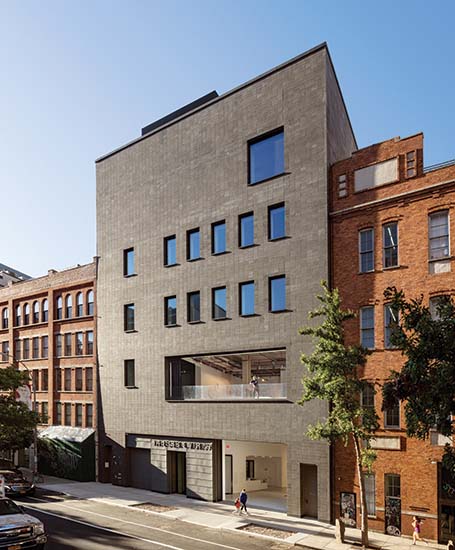
In New York’s Chelsea, known for its art galleries, a dark fly ash concrete block, zinc panels, and black-painted steel framing distinguish the north facade. Photo © Nicholas Venezia, click to enlarge.
Selldorf has been associated with Hauser & Wirth since Iwan and Manuela Wirth and Ursula Hauser founded the gallery in 1992 in Zurich. Her array of adaptive-reuse projects for their art establishments has ranged from a brewery complex in Zurich to a former flour mill in Los Angeles, a townhouse on Manhattan’s Upper East Side, and what was, until a few years ago, the former Roxy roller rink and disco in Chelsea.
Like the Zwirner, Hauser & Wirth’s new structure, a five-story, 36,000-square-foot building, commands attention, yet its austere exterior is not a buttery poured-in-place concrete—it is a recycled fly ash concrete block, charcoal-colored and gritty in its gestalt. The crisply modular blocks are honed, not polished. “It’s texturally nice to touch,” says Selldorf. “I’ve always liked black. I wanted this color to express depth and dimension.” Zinc panels and black-painted steel frames add to the facade’s flinty integrity.
Selldorf points out that the dark concrete block fits in with Hauser & Wirth’s own adventurous attitude toward art installations. The new building rises cheek by jowl with an existing loft-like gallery Hauser & Wirth leased from the Dia Art Foundation, where it has installed the famous down ’n’ dirty Roth Bar (an operational bar/café honoring the late artist Dieter Roth). For the new gallery next door, which replaces a smaller warehouse, Selldorf kept a certain rough feel, while still adhering to her astringent aesthetic.
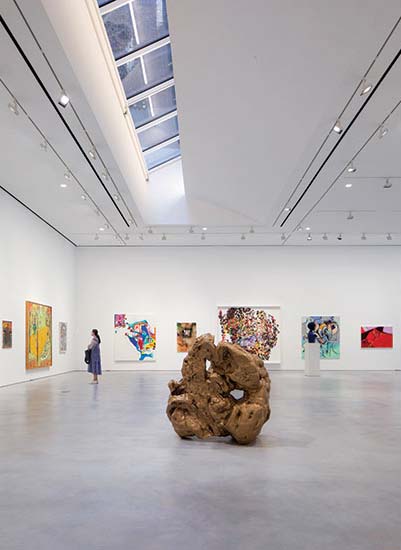
A skylight illuminates the back of the ground floor. Photo © Nicholas Venezia
The structure’s concrete frame allows 16-foot-high glazed doors to pierce the street elevation of the ground floor and for 12-foot-high folding glass doors (with a glass balustrade) to bring more space and light into the second floor. Column-free interiors easily accommodate differently sized installations against a smooth backdrop of white plaster walls and polished concrete floors.
As visitors proceed through the ground floor, they discover a large rectangular skylight running across the back of the L-shaped exhibition space. Since special district zoning required a setback of 20 feet from the rear property line above the first floor, the architects extended the ground floor into the backyard and placed this glazed insertion, supported on a 75-foot-long beam, on its roof. The daylight supplements LED track lighting, and, when needed, solar and blackout shades mitigate glare.
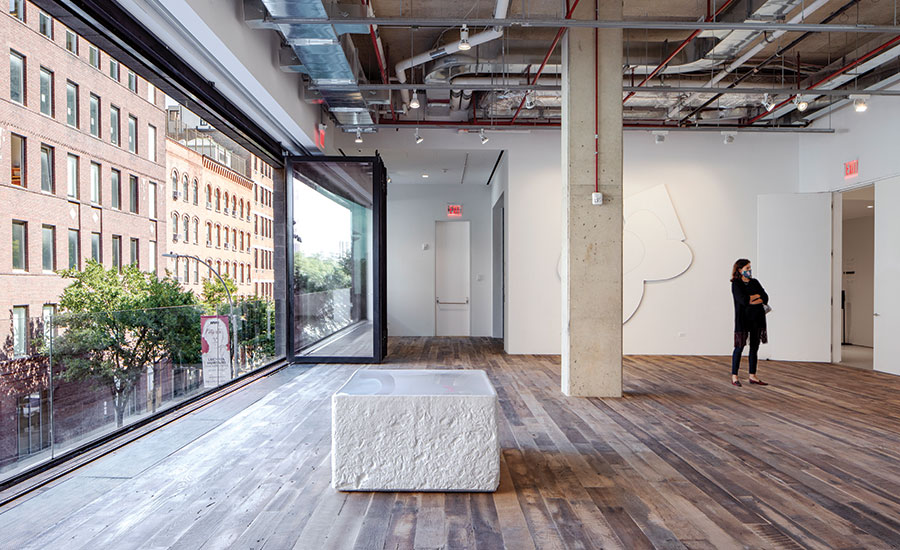
Folding glass panels and balustrade enclose a gallery/café/book- store space on the second level. Photo © Nicholas Venezia
Visitors who take the trim black-steel frame and mesh fire stair to the second floor find that a gallery/café/bookshop area overlooks the street through those folding glass panels. Its exposed ceiling and rough-hewn reclaimed-wood floor planks give this space a brute character quite different from the rest of the subdued interiors. Since the third and fourth floors are reserved for offices and client viewing rooms, gallerygoers can hop the elevator to the 18-foot-high fifth-floor gallery (or stay with the stairs). Here the column-free space is topped by a large 20-by-45-foot monitor projecting up 4 more feet, fitted with clerestories on four sides. On top is an aluminum 10-by-20-foot hatch, so art pieces too large for the loading elevator can be dropped in by crane. The museum-grade HVAC is located on a mezzanine between the first and second floor.
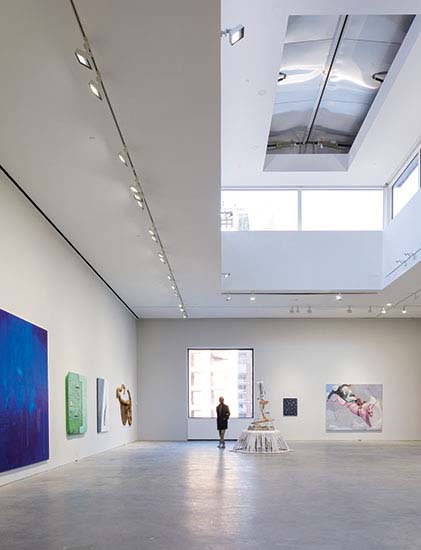
Bands of clerestories top the fifth floor. Photo © Nicholas Venezia
The inaugural exhibition in October—a variegated assemblage of contemporary art sold to benefit art institutions financially affected by Covid-19—tested the interior’s adaptability for display. Selldorf’s spare environment provided a foil for the brash, larky work of George Condo, Lynda Benglis, and Kara Walker, among others. She will have more opportunity to prove her architectural mettle in the near future as construction on the extension to the Frick Collection on the Upper East Side gets under way this spring. There, in the land of stately Beaux-Arts and Georgian-style residences and institutions, the architect’s abstracted Loosian proclivities, as expressed on the design’s exterior, could unsettle the neighbors. But her careful attention to materials and detailing attest to Modernism’s capacity for luxe, calme, and volupté.
Click plans to enlarge
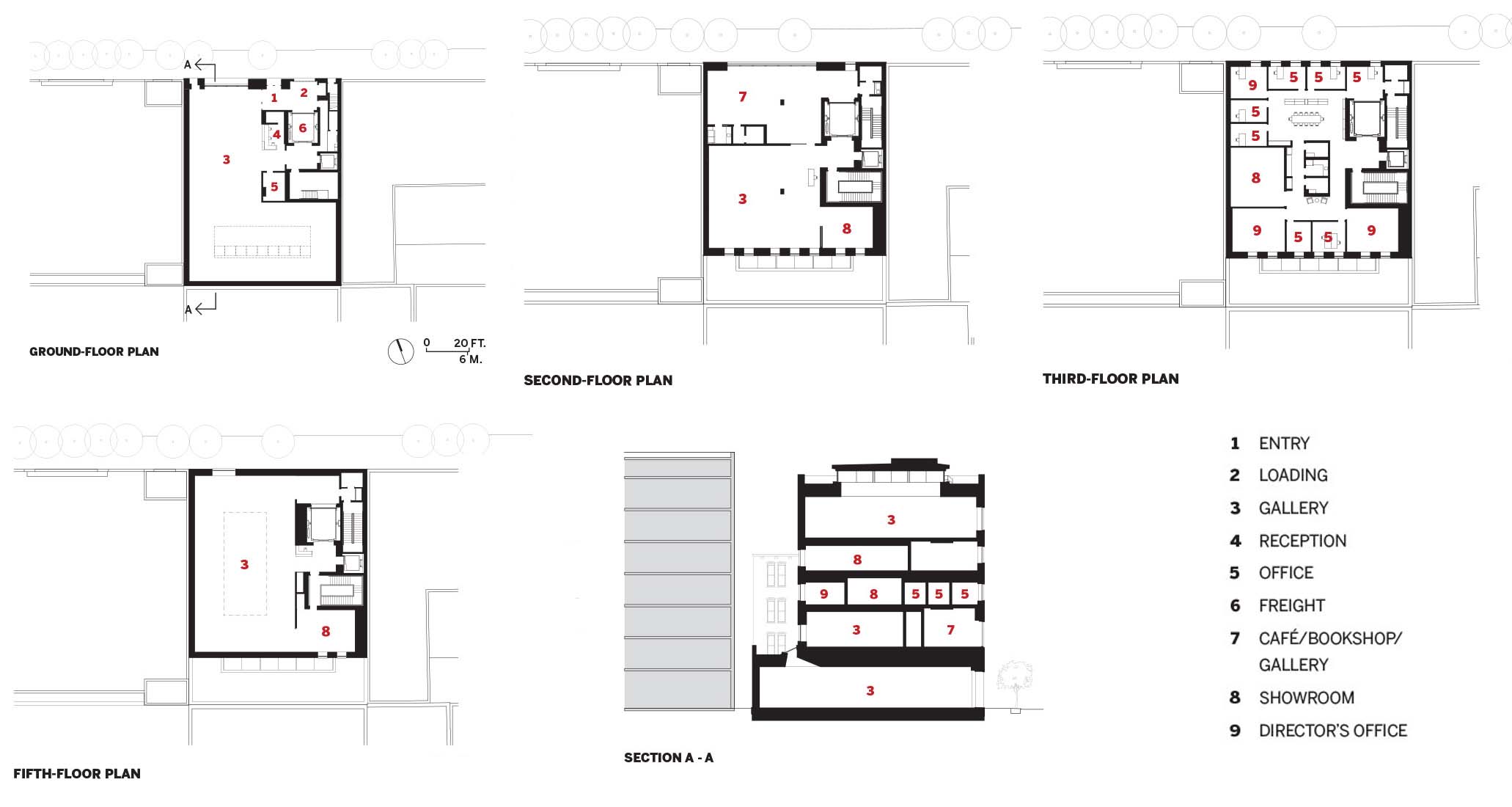
Credits
Architect:
Selldorf Architects — Annabelle Selldorf, principal and lead designer; Sara Lopergolo, partner in charge; Michael Baskett, Melissa Rivers, project managers
Engineers:
GZA GeoEnvironmental, Derosier Engineering (civil); DeSimone Consulting Engineers (structural); Frank Seta & Associates (envelope); Arup (m/e/p)
General Contractor:
Westerman Construction
Consultants:
Dharam Consulting, (estimator); Flux Studio (lighting); Synergy Associates (IT)
Client:
Hauser & Wirth
Size:
36,000 square feet
Cost:
Withheld
Completion Date:
September 2020
Sources
Masonry:
Kingston Block
Metal Panels:
VM Zinc (ground); Dri-Design (rooftop clerestory)
Metal Frame Windows and Skylights:
Schuco
Glazing:
Saint Gobain



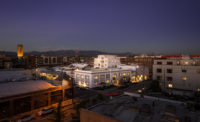

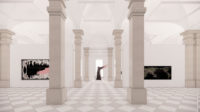
Post a comment to this article
Report Abusive Comment